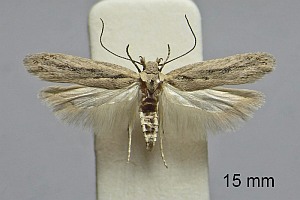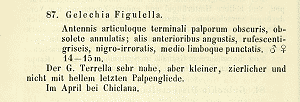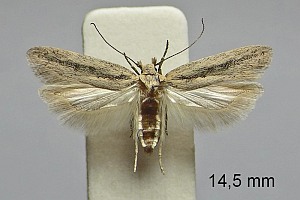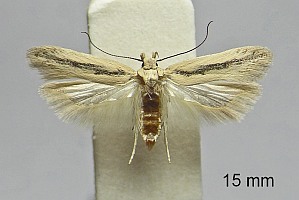

 +10Kontinente:EU
+10Kontinente:EU2. Diagnose
2.1. Männchen
2.2. Weibchen
2.3. Erstbeschreibung
3. Biologie
3.1. Nahrung der Raupe
- [Fabaceae:] Lotus creticus ? (Kreta-Hornklee, Kretischer Hornklee ?)
- [Caryophyllaceae:] Silene nicaeensis ???
Stainton (1869: 219) schreibt: "The last specimen was bread from a larva found on the 28th of February in the sand at the roots of some plants of Silene nicaeensis, in a sandy Wood near the sea to the east of Cannes. [...] As this larva did not feed after I found it, I cannot say what is ist Food-plant, unless it fed on the Silene nicaeensis, at the roots of which it was found. I cannot call to mind that there was any moss where I found it; the sand was perfectly loose and shifting." Stainton (1869: 357) ergänzt: "Silene nicaeensis, p. 219: One larva and several pupae of Gelechia figulella found at the roots of this plant, February 28th."
Karsholt & Rutten (2005: 85) widersprechen: "All Bryotropha seem to feed on mosses (Bryophyta). They are more or less polyphagous on these and the menu of some also includes grasses. A couple of unconfirmed records also give Caryophyllaceae (see under B. italica and B. figulella) and Salicaceae (see under B. dryadella) as food plants. The larva lives in a silken tube spun to the host plant. These tubes are usually flimsy. Plant material and sand are often incorporated but not frass." S. 119 ist dann zu B. figulella zu lesen: "The early stages are unknown. Two specimens in the BMNH are labelled: ‘France, Cannes, e.l. 10. & 27.vi.1867, from Silene nicaeensis collected 28/2’, but it is uncertain whether the larvae actually fed on that plant (Stainton 1869). Adults have been collected at low altitudes from late April to early October, probably in two generations." Damit wird unklar, ob es sich bei Silene nicaeensis tatsächlich um eine Nahrungspflanze dieser Raupe handelt - auszuschließen ist es aber auch nicht.
Nochmals ganz anders Huertas-Dionisio (2010), der in Südspanien die Raupe in Gespinstschläuchen im Sand an Lotus creticus fand und mit dieser Pflanze bis zum Falter erzog: Las orugas fueron encontradas en tubos de seda cubiertos de arena entre los tallos de Lotus creticus L., en las dunas de las playas; en algunos casos también se hallaron los capullos, de forma característica (fig. 15). Estas orugas se trasladaron a botes de cristal de boca ancha, con fondo de arena y su planta nutricia, en los que se siguió su ciclo biológico hasta la salida de los adultos."
Es bleiben also viele Fragen offen.
(Autor: Erwin Rennwald)
4. Weitere Informationen
4.1. Andere Kombinationen
- Gelechia figulella Staudinger, 1859 [Originalkombination]
4.2. Synonyme
- Gelechia capnella Constant, 1865
- Bryotropha cinnamomea Turati, 1934 [synonymisiert durch Karsholt & Rutten, 2005]
4.3. Faunistik
Aus Großbritannien gibt es zwar eine alte Meldung, diese ist aber zu streichen. Auf der Artseite von [Hantsmoths.org.uk] ist dazu zu lesen: "Occurrence in the British Isles unconfirmed. One was believed to have been taken on waste ground near the sea at Aldeburgh, Suffolk on 20 July 1892. It is now generally accepted that the record was based on misidentification."
(Autor: Erwin Rennwald)
4.4. Literatur
- Huertas-Dionisio, M. (2010): Estados inmaturos de Lepidoptera (XXXVIII). Bryotropha figulella (Staudinger, 1859) en Huelva, España (Lepidoptera: Gelechiidae). — SHILAP Revista de Lepidopterología 38 (150): 133-137. Madrid [PDF auf www.redalyc.org].
- Karsholt, O. & T. Rutten (2005): The genus Bryotropha Heinemann in the western Palaearctic (Lepidoptera: Gelechiidae). — Tijdschrift voor Entomologie 148: 77-207. [PDF auf nev.nl]
- Stainton, H.T. (1869): The Tineina of Southern Europe. i-viii + 1-372 + 1 pl. London (John van Voorst).
- Erstbeschreibung: Staudinger, O. (1859): Diagnose nebst kurzen Beschreibungen neuer andalusischer Lepidopteren. — Entomologische Zeitung 20 (7-9): 211-259. Stettin.

















